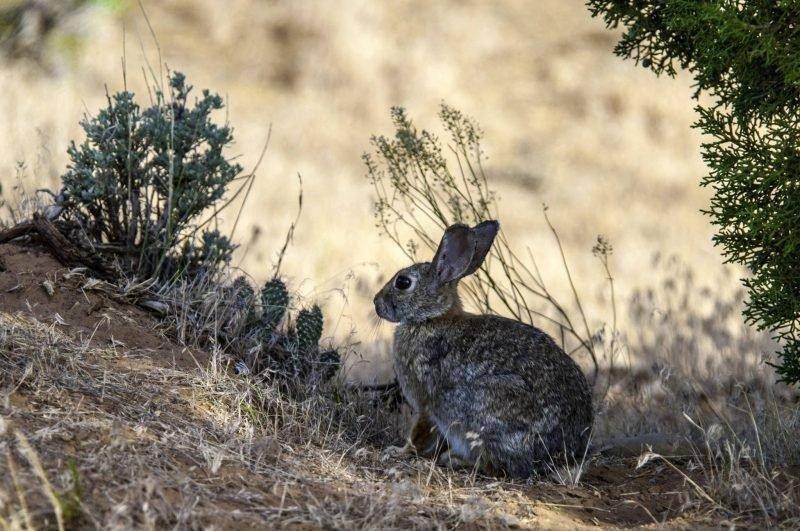DWR Press Release
The number of cottontail rabbits in Utah has dropped a bit from last year. But rabbit numbers are still at the top of a 10-year population peak. And snowshoe hares in Utah are doing really well too.
Hunts for both upland game animals start Sept. 1. You can see where rabbits and hares live in Utah, and learn more about them, on pages 38, 48 and 49 of the 2017 – 2018 Utah Upland Game and Turkey Guidebook. You can get the free guidebook at www.wildlife.utah.gov/guideboo
Cottontail rabbits
Biologists aren’t sure why it occurs, but cottontail rabbits across the country experience a 10-year population cycle. After bottoming out, the number of cottontails will climb slowly for about five years. Once the population peaks in number, it will usually stay close to the peak for about three years. Then, numbers will abruptly fall for a couple of years until the population bottoms out and numbers start to climb again.
From late July through mid-August, DWR biologists count rabbits along 15 survey routes in the state. Division of Wildlife Resources Upland Game Coordinator Jason Robinson is compiling data received from the biologists. He says preliminary results show Utah’s rabbit population is likely in the last year of its population peak.
“It looks like rabbit numbers have dropped a bit,” Robinson says, “but not much. I think hunter success—in parts of Utah—will be well above average this year.”
Duchesne and Uinta counties in northeastern Utah continue to hold the highest numbers of rabbits. Counties in southeastern, south-central and southwestern Utah hold the next highest numbers. “Counties in northern and central Utah have the lowest number of rabbits,” he says.
Robinson says the cottontail rabbit hunt is a great hunt for hunters of all ages and abilities, including those who are just getting started. “The terrain rabbits live in is usually relatively flat and easy to walk through,” he says. “The equipment needed is basic, light and easy to carry. And, if you get into a bunch of rabbits, you’ll get lots of shots.”
Finding rabbits
To find rabbits in lower elevations, look in the bottom of valleys that have tall sagebrush and deep, loose soil that have burrows the rabbits can hide in. If you’re in mid-elevation areas, look for hillsides that have large boulders, thick sagebrush or other thick vegetation in which the rabbits can hide.
Also, consider hunting early in the morning and late in the afternoon. “That’s when rabbits are away from their resting areas and are the most active,” Robinson says. “Early morning and late in the afternoon are prime times for rabbits to feed.”
Hunting tips
Shotguns and small-caliber rifles, such as the .22, are perfect firearms to hunt rabbits with.
If you’re hunting with a small-caliber rifle, finding a spot that’s higher in elevation than the area around it—and then sitting down, scanning the surrounding area and waiting for rabbits to appear—is a good choice. It’s critical to hunt early in the morning or late in the afternoon, when rabbits are the most active and moving around.
If you’d like to walk and flush rabbits out of cover, a shotgun is the best firearm to use. If you’re hunting with one or more people, form a line—spacing each hunter about 20 yards apart—and then walk through areas that look promising. Be ready to click your safety off: a flushing rabbit doesn’t give you much time to shoot!
Snowshoe hare
While cottontail rabbit numbers will likely be down a bit, the number of snowshoe hares should be up. Abundant snow and rain last winter and spring is the reason why.
“Hares eat needles and twigs from evergreen trees,” Robinson says, “so it doesn’t matter how deep the snow gets. Hares can always get on top of the snow and find something to eat.”
The abundant moisture left plenty of green vegetation for does as they entered the breeding season. Because the does were healthy, they likely gave birth to additional baby hares, called leverets. And the abundant green vegetation provided lots of buds and shoots for the leverets to eat.
“We don’t conduct formal surveys for snowshoe hares,” Robinson says, “but based on habitat conditions and the number of hares biologists have seen while working in the field, it looks like the number of snowshoe hares will be above average this year.”
Finding hares
Snowshoe hares live in high-elevation stands of conifer and aspen trees. Stands of young pine trees—at least 8,000 to 9,000 feet in elevation—are especially attractive to hares.
In Utah, hares live along the Wasatch Plateau (the range of mountains that run north to south, through the center of the state) and east into the Uinta Mountains.
If you live along the Wasatch Front, a good area to look is the Uinta Mountains east of U.S. Highway 150 (also known as the Mirror Lake Highway). Logan Canyon is also an area worth checking out.
“Waiting for the first snowstorm of the year,” Robinson says, “and then looking for the hares’ unique footprint, is one of the best ways to find them. The print looks like a miniature snowshoe.”
Robinson says snowshoe hares don’t have a large home range. “If you find an area that has lots of tracks in it,” he says, “there’s a good chance a hare is hunkered down in some vegetation nearby.”
Snowshoes or snowmobiles are often required to hunt snowshoe hares after the snow falls.
Hunting tips
Small-caliber rifles and shotguns are great firearms to use. Move slowly through the hares’ habitat, watching for the outline of a hare and its dark black eyes. Kicking brush piles can also cause hares that are hiding to flush into the open.

